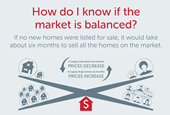
First-time buyers are set to enter the market in droves, but many are concerned that our market’s low inventory will affect their ability to purchase. Below, we outline the spring market conditions and what they mean for both buyers and sellers across Minnesota and western Wisconsin.
By the numbers: Low inventory, low rates
In February, our 13-county metro area saw a 23.2 percent increase in new listings, a good sign for our low inventory market. However, the new inventory isn’t making up for what wasn’t there to begin with; even with February’s new listings, there are still 2 percent fewer homes for sale this year than there were in February 2014.
Meanwhile, prices rose year-over-year by 10.4 percent, and the median sales price of a home in our area is now $202,000. Buyers were undeterred by these escalating prices, and pending sales rose nearly 22 percent in February.
Last, we are once again seeing interest rates below 4 percent, and the Minneapolis-St. Paul area was ranked as the most affordable market in the nation just this past fall.
What does it all mean? In short, the spring market is all about inventory. Let’s entertain two scenarios: one where inventory rises, and one where inventory does not.
Scenario 1: Inventory rises
From the above, we see that listings increased in February. If this trend holds and even rises, the spring market could be the best in years for buyers.
Why? Think back to your high school economics class and the rules of supply and demand. A rise in homes for sale across Minnesota and western Wisconsin would give buyers more options — and they would not have to compete over quality listings. Fading buyer competition would curtail the rising prices we’ve come to expect over the last three years.
Scenario 2: Inventory declines or stays stagnant
On the other hand, if inventory falls or remains at its current level, then supply would decline and demand would exceed it. In this situation, buyers (including first-time buyers, who will make up a large portion of the spring market) would compete over a more limited number of listings causing prices to rise as buyers enter multiple bids.
What will happen?
You’ve likely realized over the last few years that the market is not as predictable as it seems. While prices (and equity) have risen high enough that homeowners may be ready to sell their homes, there is no guarantee that enough people will list their homes for sale to create a less competitive market for buyers this spring.
What about affordability?
The good news for buyers, including first-time buyers, is that mortgage interest rates are below 4 percent and seem to be holding. These low rates are keeping home prices affordable even as prices rise.
It’s not just interest rates that are keeping buyers in the game, though. Our strong local economy and cost of living are also giving Minnesota and western Wisconsin homebuyers a leg up. According to a recent study, homebuyers in the Minneapolis area need to earn just $47,626.53 annually to afford a median priced home. While it’s not the lowest in the country, Minneapolis is much more affordable than Denver, where homeowners need to earn more than $60,000, and San Francisco, where the average homeowner needs to earn more than $142,000 annually to buy a median priced home.
The long and short of it
Across the country, rising prices and slowing inventory are creating a slowdown in pending sales. Here in Minnesota and western Wisconsin, we aren’t seeing that — remember, pending sales were up nearly 22 percent in February. This is a good sign that, between low rates and high affordability, today’s homebuyers are undeterred and many are finding homes that fit their price range and needs.
Whether you’re buying for the first time or reentering the market, keep in mind that persistence is the key to finding the home you’ll call your own. Reach out today to be connected with a real estate professional who specializes in your local market area.








